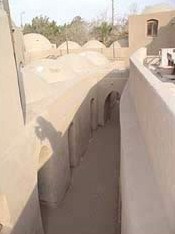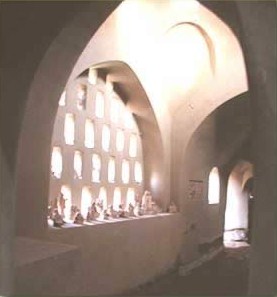Ramses Wessa Wassef Art Center
by Lara Iskander

This art center was first founded by the late Egyptian Architect and Educator Ramses Wessa Wassef in the early 1950s. He set out with a goal to prove his idea that any human being using his natural creativity is able to produce art when provided with suitable circumstances. Through this art establishment, Wessa Wassef began realizing his dream and offering people such opportunities.
Wessa Wassef was born in 1911. He earned his degree from an Art School in Paris in 1935 and upon his return to Cairo, became a professor of Art and History of Architecture in the college of Fine Arts in Cairo.
His Belief in the human beings freedom of creativity, which from his point of view was not used to its full length, drove him to form his art school. There, it would be possible for him to allow anyone, whatever his social standard or education level was, to create art.

The school is located in Haraneya village, near the Pyramids road in Giza. Wessa Wassef saw Haraneya village as a perfect choice. It would be the best place to find youngsters with no previous schooling, living a simple life away from the modern environment that usually affects the freedom of mind and its creativity. For this same reason he started his work with children since they would be still free-spirited and in touch with their imagination.


Left: Another View of the Center's Courtyard; Right: A Passage within the Complex
To commence his experiment, he chose to start working with a group of 12 children, ranging between the age of 8 and 12. The art center originally started as a tapestry weaving school, which involves a great amount of patience and dedication.
A weaver has no preliminary drawings or sketches even for large works.
The art produced is meant to come straight from the image composed in the weavers mind. Wessa Wassef considered this a life time experience, meaning that the artist or weaver was meant to grow gradually side by side with his craft.

The children first started working on small frame looms, using only a few colors in each carpet.
With time and the constant efforts of Ramses and his wife Sophie, the children gained skills and started producing designs that mainly expressed their daily life in the village. In order to broaden their horizons, Wessa Wassef took the children on many tours, visiting new places to help them capture different images in their minds.
After Wessa Wassefs death in 1974, his wife and children carried on with his dream and project, preserving these crafts and introducing new ones to new working generations.

More crafts were added to the school, such as Batik weaving and ceramics workshops. Hand made carpets were either made of 100% cotton or wool, each one with a unique design not to be reproduced.


Many Domes and Corridors of the Complex
Wessa Wassefs ideas and philosophy regarding the necessity of keeping in touch with nature was also reflected on his building techniques. The art center, a beautiful architectural complex in itself was all built in mud brick, an affordable and available material. When he began building the workshops, he brought workers from Upper Egypt where he had sensed the beauty of the Nubian architecture and its absolute harmony with the surrounding environment.

He also considered these building methods as the renaissance of the Egyptian Architecture adopted by Pharonic, Coptic and Islamic civilizations. When he started expanding the center, he began teaching the locals how to build vaulted and domed mud brick structures keeping as far as possible from the modern buildings that lacked the human touch and the environmental friendly aspect. At the same time, he offered the locals an opportunity to design their own houses, providing them with land to realize their homes that were connected later on with the art center.


Left: Outside view of the Habib Gorgi Sculpture Museum;
Right: Interior View of the Habib Gorgi Sculpture Museum
The vast grounds of Wessa Wassef art center include workshops and showrooms. Also a pottery and sculpture museum where the works of his father in-law, Habib Gorgi are displayed. And finally houses and farm buildings providing the workshops with all the necessary materials.


Left: Main Faade of the Habib Gorgi museum; Right: Interior of the Habib Gorgi museum.
The family established another museum in 1989 where all walls, domes and vaults are constructed from sun-dried earth and mud brick. It exhibits the different stages Wessa Wassef went through during his experiment.


Left: Exterior view of the Wessa Wassef Museum; Right: Interior view of the museum dome
It shows works of the first generation of children he worked with and other buildings he designed such as the Marashly Church in Zamalek and the Mahmoud Moukhtar Sculpture Museum in Cairo.
The art produced at the Haraneya art center is exhibited all over the world. The first exhibition of the tapestries took place in 1957 in Egypt followed by another in Switzerland.
This unforgettable unique experiment had different successful impacts in various ways; apart from ensuring the revival and preservation of old crafts, it offered worldwide fame to the Haraneya village where the hand made carpet industry has expanded in the whole area.
Ramses Wessa Wassef s Art center was the recipient of the Aga Khan Award for Architecture in 1983.
References:
- First hand account by author

